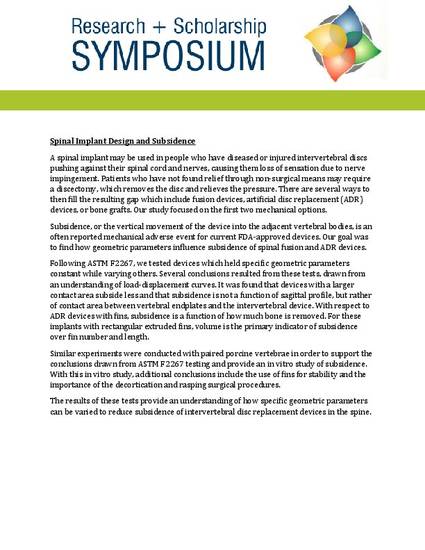
- Spine,
- subsidence,
- disc replacement,
- ASTM,
- fusion,
- ADR
A spinal implant may be used in people who have diseased or injured intervertebral discs pushing against their spinal cord and nerves, causing them loss of sensation due to nerve impingement. Patients who have not found relief through non-surgical means may require a discectomy, which removes the disc and relieves the pressure. There are several ways to then fill the resulting gap which include fusion devices, artificial disc replacement (ADR) devices, or bone grafts. Our study focused on the first two mechanical options.
Subsidence, or the vertical movement of the device into the adjacent vertebral bodies, is an often reported mechanical adverse event for current FDA-approved devices. Our goal was to find how geometric parameters influence subsidence of spinal fusion and ADR devices.
Following ASTM F2267, we tested devices which held specific geometric parameters constant while varying others. Several conclusions resulted from these tests, drawn from an understanding of load-displacement curves. It was found that devices with a larger contact area subside less and that subsidence is not a function of sagittal profile, but rather of contact area between vertebral endplates and the intervertebral device. With respect to ADR devices with fins, subsidence is a function of how much bone is removed. For these implants with rectangular extruded fins, volume is the primary indicator of subsidence over fin number and length.
Similar experiments were conducted with paired porcine vertebrae in order to support the conclusions drawn from ASTM F2267 testing and provide an in vitro study of subsidence. With this in vitro study, additional conclusions include the use of fins for stability and the importance of the decortication and rasping surgical procedures.
The results of these tests provide an understanding of how specific geometric parameters can be varied to reduce subsidence of intervertebral disc replacement devices in the spine.
Available at: http://works.bepress.com/timothy_norman/149/
